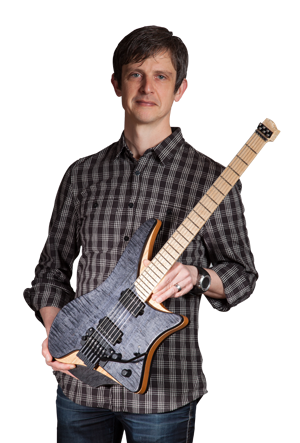So, will it be ergonomic? I hope so, and I think so. To sanity check the design slightly, I made a 1:1 scale cardboard mock-up to mess around with. Out of the four different playing positions, the last one may not be feasible, but the other three felt very, very good. Next, having verified that it will be a working design, I’ll start making the routing template for the...
Learn MoreErgonomic guitar design only solves half (OK, maybe a little bit more) of the problem. What about the picking hand? Little Guitar Works have looked at the picking hand for basses, and have a patented solution that includes it. I wish I knew who did another piece: I was very happy to find one in an old guitar case that I hadn’t opened for a looong time. I had another pick as well, made from some kind of animal horn. The one in the picture is made from some kind of bone. They are amazing if you ask me! I did like the horn one better and it was pretty worn, but I can’t find it. Not only do they give the picking hand fingers a more natural position, but as you can see the edge of the pick is twisted in relation to the fingers. This allows the edge to hit the strings “straight” when your wrist is in its most natural position. The difference compared to a regular pick is astonishing. I made a whole bunch of twisted plastic picks with some pliers and a hot air gun that do the same thing, but they don’t sound half as good though. These bone/horn picks give a...
Learn MoreI was toying around with the thought of fanned frets over the weekend. It seems to me as if fanned frets would be an ergonomic feature just as well as twisting the neck – giving a more comfortable wrist position. Anyway, I will not argue for or against. When I sketched up the fanned shape, however, the shape that I had designed for this build didn’t look good anymore. I will not incorporate fanned frets in this build, but I couldn’t help drawing up some new shapes: I have been very inspired by Rick Toone’s builds, which is pretty apparent. Almost all of these shapes build on being carved in multiple dimensions as if consisting of composite shapes that are intertwined. I’m still set to go with the original designs. Maybe the above ones will make it into a future...
Learn MoreAs previously advertised, I got hold of some dry composite glide bearings. I have now tested them and it all works perfectly, even though the not yet knurled knob is aluminum. Once I get the intended threads (M6x0,5 mm as opposed to the current M6x0,75) it will be even better. Here are some pictures: I have also been in touch with ESSDE here in town about getting a bunch of these made and am awaiting to hear what the damages will be. I have also reached out to some luthiers about getting Lacewood, which seems like an interesting choice for the body. It was not available in Sweden with any of the places that I have done business with in the past. Please let me know if you have any...
Learn MoreTwo things about the neck design: Looking at what people who have put much more thought into this than I have have arrived at, it might not be as simple as regarding the neck as a slice of a cone when you want to twist it. Having said that, the same people tell us that the original patent was difficult to realize and filed a follow-up that simplifies matters and goes back largely to the “original” design, Burrel’s patent. Secondly, again going back to the Orchid bass that I can’t seem to stop raving about, I was curious to test a trapezoidal design. One of the reasons being that it is easier to fit a square aluminum beam into a neck with that shape. It is not easier when the neck is twisted though, but I’ll deal with that some other time. Luckily, it turned out that my TV Remote had a perfect trapezoidal shape! It is almost the same width as a guitar neck and it tapers from 16 mm to 26 mm at the thickest end. Playing around with it, I did feel as if I could reach the low (i.e. top from the floor) strings more easily and comfortably with the trapezoidal shape. It felt...
Learn MoreI thought that one could have interchangeable “headstocks” on the neck – mostly for looks, so I drew some alternatives: I have solid alternatives but also ones made from a 6 mm rectangular bar. The headstocks would be prepared for special string fasteners that would allow running the string through and locking them with an insex screw. These would be bolted onto/into the headstock. But when I looked at the complete guitar, it was completely non-proportional. It turns out that the body is so small that it will not accommodate a full-size headstock. I created a Strat comparison for reference: (Strat body shape borrowed from Warmoth) So, I guess I will need to use a smaller one like the bottom right ones for it to make sense. Although, having seen the Orchid bass, I might re-design the whole...
Learn More


